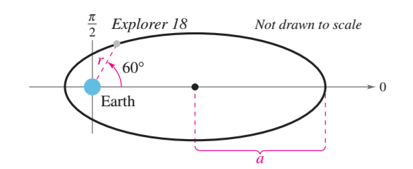
(a)
To find: the polar equation of the orbit
(a)
Answer to Problem 64E
The polar equation of the orbit is
Explanation of Solution
Given:
Its low and high points above the surface of Earth were about 119 miles and 122,800 miles, respectively.
The radius of Earth is 4000 miles

Calculation:
Write the expression for the aphelion.
Write the expression for the perihelion.
Divide the aphelion by the perihelion. Solve for e.
Use to and the expression for the aphelion to find a.
Use the equation given in exercise 49. Plug in the a and e.
Conclusion:
Therefore, the polar equation of the orbit is
(b)
To find: the distance between the surface of Earth and the satellite
(b)
Answer to Problem 64E
The distance between the surface of Earth and the satellite is
Explanation of Solution
Given:
Calculation:
Use the result of part a.
Subtract 4000 to find the distance to the surface of the Earth.
Conclusion:
Therefore, the distance between the surface of Earth and the satellite is
(c)
To find: the distance between the surface of Earth and the satellite
(c)
Answer to Problem 64E
The distance between the surface of Earth and the satellite is
Explanation of Solution
Given:
Calculation:
Use the result of part a.
Subtract 4000 to find the distance to the surface of the Earth.
Conclusion:
Therefore, the distance between the surface of Earth and the satellite is
Chapter 9 Solutions
PRECALCULUS W/LIMITS:GRAPH.APPROACH(HS)
- Force with 800 N and 400 N are acting on a machine part at 30° and 60°, respectively with a positive x axis, Draw the diagram representing this situationarrow_forwardI forgot to mention to you to solve question 1 and 2. Can you solve it using all data that given in the pict i given and can you teach me about that.arrow_forwardexam review please help!arrow_forward
 Calculus: Early TranscendentalsCalculusISBN:9781285741550Author:James StewartPublisher:Cengage Learning
Calculus: Early TranscendentalsCalculusISBN:9781285741550Author:James StewartPublisher:Cengage Learning Thomas' Calculus (14th Edition)CalculusISBN:9780134438986Author:Joel R. Hass, Christopher E. Heil, Maurice D. WeirPublisher:PEARSON
Thomas' Calculus (14th Edition)CalculusISBN:9780134438986Author:Joel R. Hass, Christopher E. Heil, Maurice D. WeirPublisher:PEARSON Calculus: Early Transcendentals (3rd Edition)CalculusISBN:9780134763644Author:William L. Briggs, Lyle Cochran, Bernard Gillett, Eric SchulzPublisher:PEARSON
Calculus: Early Transcendentals (3rd Edition)CalculusISBN:9780134763644Author:William L. Briggs, Lyle Cochran, Bernard Gillett, Eric SchulzPublisher:PEARSON Calculus: Early TranscendentalsCalculusISBN:9781319050740Author:Jon Rogawski, Colin Adams, Robert FranzosaPublisher:W. H. Freeman
Calculus: Early TranscendentalsCalculusISBN:9781319050740Author:Jon Rogawski, Colin Adams, Robert FranzosaPublisher:W. H. Freeman
 Calculus: Early Transcendental FunctionsCalculusISBN:9781337552516Author:Ron Larson, Bruce H. EdwardsPublisher:Cengage Learning
Calculus: Early Transcendental FunctionsCalculusISBN:9781337552516Author:Ron Larson, Bruce H. EdwardsPublisher:Cengage Learning





